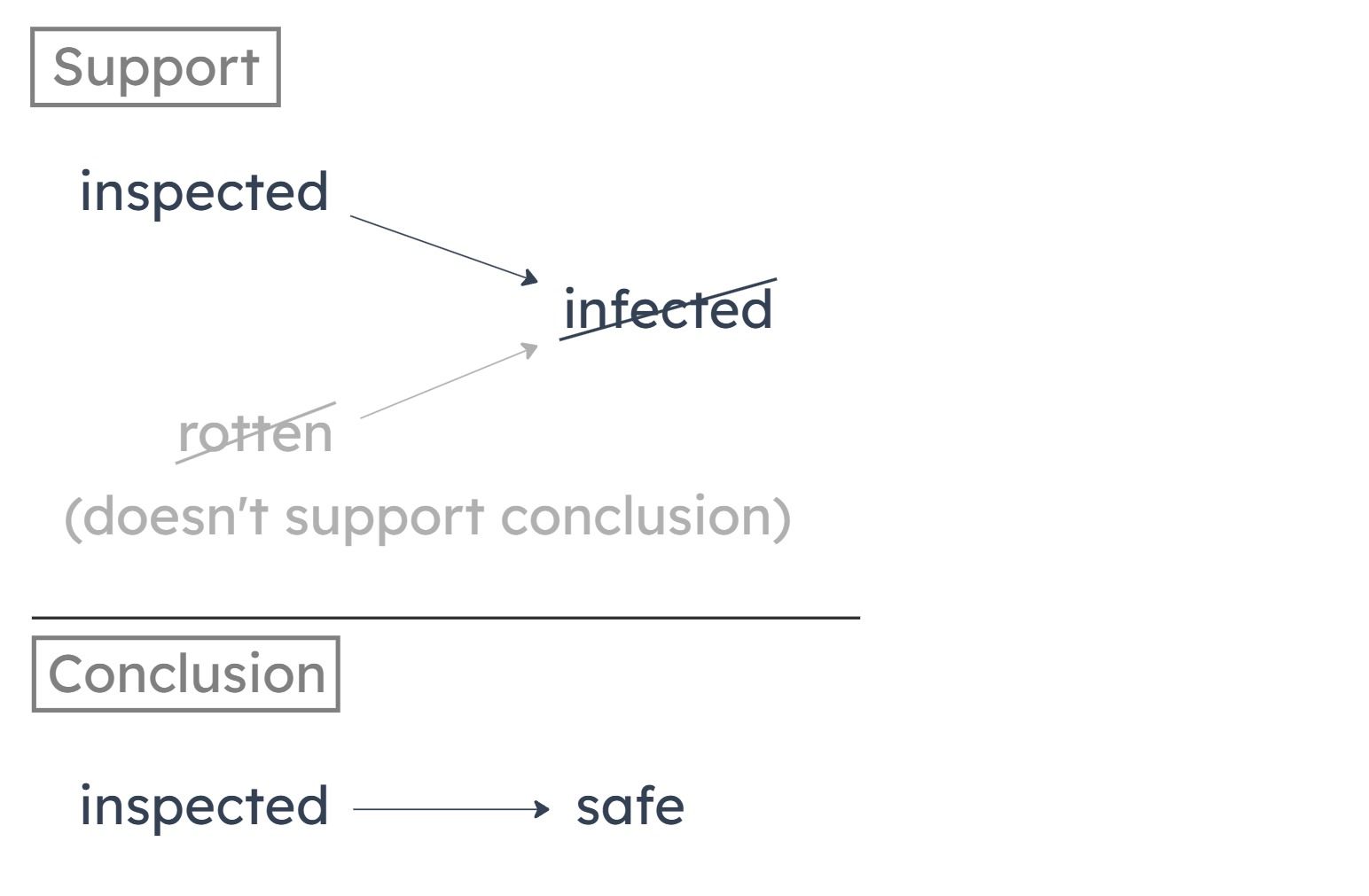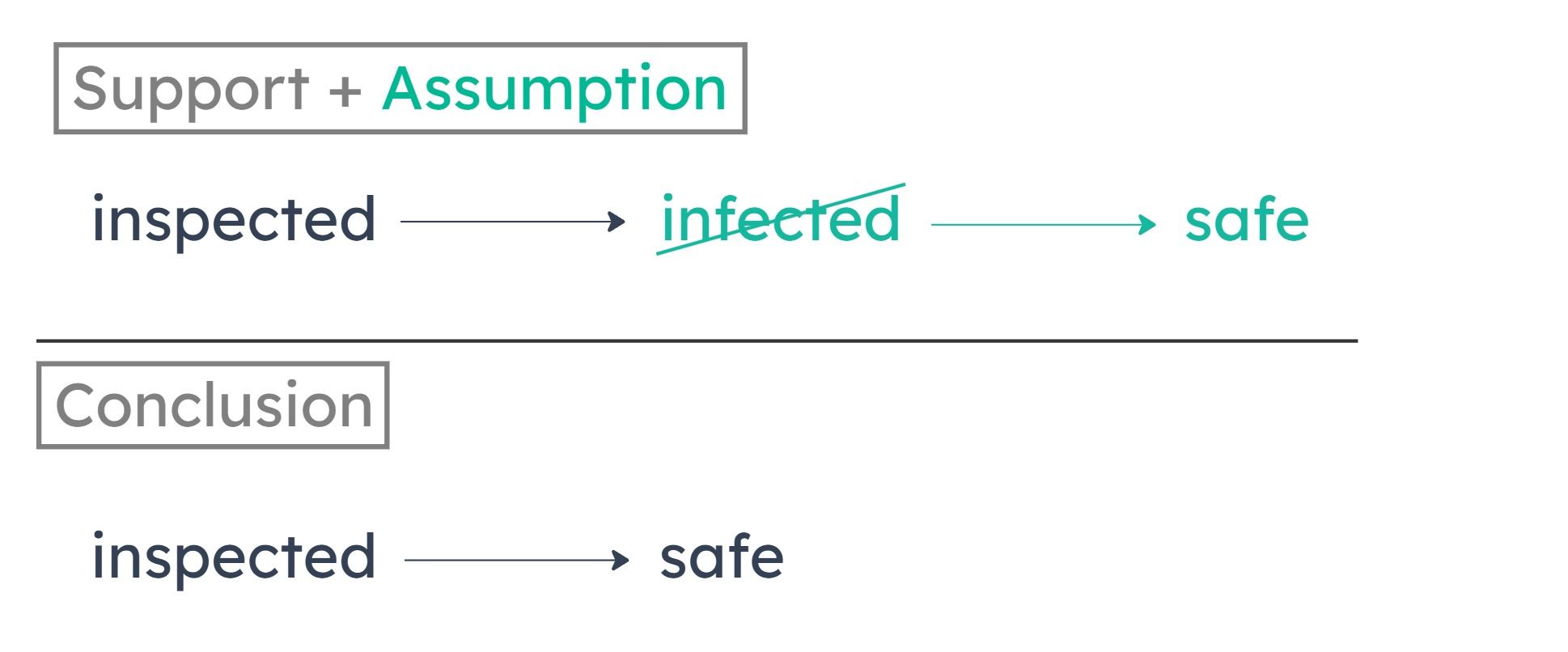LSAT 122 – Section 2 – Question 07
LSAT 122 - Section 2 - Question 07
June 2006You need a full course to see this video. Enroll now and get started in less than a minute.
Target time: 1:43
This is question data from the 7Sage LSAT Scorer. You can score your LSATs, track your results, and analyze your performance with pretty charts and vital statistics - all with a Free Account ← sign up in less than 10 seconds
| Question QuickView |
Type | Tags | Answer Choices |
Curve | Question Difficulty |
Psg/Game/S Difficulty |
Explanation |
|---|---|---|---|---|---|---|---|
| PT122 S2 Q07 |
+LR
| Sufficient assumption +SA Conditional Reasoning +CondR Link Assumption +LinkA | A
8%
158
B
23%
161
C
2%
155
D
15%
160
E
53%
166
|
152 162 173 |
+Hardest | 146.896 +SubsectionMedium |
Summary
The author concludes that any fruit that was inspected is safe to eat.
This is supported by the claim that any fruit that was inspected is not infected. (This is a translation of “No fruit that was inspected is infected.”)
The claim “any fruit that is infected is also rotten” plays no role in supporting the conclusion, because it doesn’t connect to the concept of “inspected” or “safe to eat.”
This is supported by the claim that any fruit that was inspected is not infected. (This is a translation of “No fruit that was inspected is infected.”)
The claim “any fruit that is infected is also rotten” plays no role in supporting the conclusion, because it doesn’t connect to the concept of “inspected” or “safe to eat.”

Missing Connection
We know from the premise that fruits that were inspected are not infected. But does this imply that those fruits are safe to eat? We don’t have anything that establishes what’s safe to eat.
We want to establish that if a fruit is not infected, then it’s safe to eat.
We want to establish that if a fruit is not infected, then it’s safe to eat.
A
It is not safe to eat any fruit that is rotten.
This establishes that if a fruit is rotten, it’s not safe to eat. But we want to establish what kind of fruit IS safe to eat. An answer establishing that something is NOT safe to eat does not prove that something IS safe to eat. Also, we don’t know whether fruits that are inspected are or are not rotten. So “rotten” doesn’t connect to anything relevant to the conclusion.
B
It is safe to eat any fruit that is not rotten.
We don’t know whether fruits that are inspected are or are not rotten. So (B) doesn’t help establish that fruits that are inspected are safe to eat. You might have mistakenly thought that fruits that are not infected are not rotten — but none of the premises establishes this relationship.
C
It would have been safe to eat infected fruit if it had been inspected.
The conclusion concerns fruits that were inspected and that are not infected. What would be true about infected fruits had they been inspected doesn’t affect fruits that were in fact inspected.
D
It is not safe to eat any fruit that is infected.
We want to establish what kind of fruit IS safe to eat. An answer establishing that something is NOT safe to eat does not prove that something IS safe to eat. (D) leaves open the possibility that it might still be unsafe to eat fruits that are uninfected; those fruits might be unsafe to eat for other reasons unrelated to infection.
E
It is safe to eat any fruit that is uninfected.
(E) establishes that if a fruit is uninfected, it is safe to eat. Since we know that fruits that are inspected are not infected, (E) proves that fruits that are inspected are safe to eat.

Cookie Cutter Review
SA question, heavy use of lawgic, formulaic
Take PrepTest
Review Results
LSAT PrepTest 122 Explanations
Section 1 - Logical Reasoning
- Question 01
- Question 02
- Question 03
- Question 04
- Question 05
- Question 06
- Question 07
- Question 08
- Question 09
- Question 10
- Question 11
- Question 12
- Question 13
- Question 14
- Question 15
- Question 16
- Question 17
- Question 18
- Question 19
- Question 20
- Question 21
- Question 22
- Question 23
- Question 24
- Question 25
Section 2 - Logical Reasoning
- Question 01
- Question 02
- Question 03
- Question 04
- Question 05
- Question 06
- Question 07
- Question 08
- Question 09
- Question 10
- Question 11
- Question 12
- Question 13
- Question 14
- Question 15
- Question 16
- Question 17
- Question 18
- Question 19
- Question 20
- Question 21
- Question 22
- Question 23
- Question 24
- Question 25
- Question 26
Section 3 - Reading Comprehension
- Passage 1 – Passage
- Passage 1 – Questions
- Passage 2 – Passage
- Passage 2 – Questions
- Passage 3 – Passage
- Passage 3 – Questions
- Passage 4 – Passage
- Passage 4 – Questions
Leave a Reply
You must be logged in to post a comment. You can get a free account here.